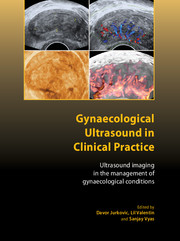 Gynaecological Ultrasound in Clinical Practice
Gynaecological Ultrasound in Clinical Practice Book contents
- Frontmatter
- Contents
- About the authors
- Abbreviations
- Preface
- 1 Ultrasound imaging in gynaecological practice
- 2 Normal pelvic anatomy
- 3 The uterus
- 4 Postmenopausal bleeding: presentation and investigation
- 5 HRT, contraceptives and other drugs affecting the endometrium
- 6 Diagnosis and management of adnexal masses
- 7 Ultrasound assessment of women with pelvic pain
- 8 Ultrasound of non-gynaecological pelvic lesions
- 9 Ultrasound imaging in reproductive medicine
- 10 Ultrasound imaging of the lower urinary tract and uterovaginal prolapse
- 11 Ultrasound and diagnosis of obstetric anal sphincter injuries
- 12 Organisation of the early pregnancy unit
- 13 Sonoembryology: ultrasound examination of early pregnancy
- 14 Diagnosis and management of miscarriage
- 15 Tubal ectopic pregnancy
- 16 Non-tubal ectopic pregnancies
- 17 Ovarian cysts in pregnancy
- Index
7 - Ultrasound assessment of women with pelvic pain
Published online by Cambridge University Press: 05 February 2014
- Frontmatter
- Contents
- About the authors
- Abbreviations
- Preface
- 1 Ultrasound imaging in gynaecological practice
- 2 Normal pelvic anatomy
- 3 The uterus
- 4 Postmenopausal bleeding: presentation and investigation
- 5 HRT, contraceptives and other drugs affecting the endometrium
- 6 Diagnosis and management of adnexal masses
- 7 Ultrasound assessment of women with pelvic pain
- 8 Ultrasound of non-gynaecological pelvic lesions
- 9 Ultrasound imaging in reproductive medicine
- 10 Ultrasound imaging of the lower urinary tract and uterovaginal prolapse
- 11 Ultrasound and diagnosis of obstetric anal sphincter injuries
- 12 Organisation of the early pregnancy unit
- 13 Sonoembryology: ultrasound examination of early pregnancy
- 14 Diagnosis and management of miscarriage
- 15 Tubal ectopic pregnancy
- 16 Non-tubal ectopic pregnancies
- 17 Ovarian cysts in pregnancy
- Index
Summary
Introduction
Pelvic pain is a common gynaecological complaint and ultrasound examination is often performed in an attempt to identify its cause. The ultrasound scan, however, should not be used as a substitute for clinical history and examination. The best use of ultrasound is to confirm or exclude a diagnosis that we suspect on the basis of clinical data. There are several painful conditions that can be seen and diagnosed with ultrasound. This is particularly true of acute painful conditions. However, chronic pelvic pain is a different clinical entity. There is no accepted definition of chronic pelvic pain and there is much controversy about what conditions may explain it. Some conditions that have been suggested to cause chronic pelvic pain, such as neuralgia or irritable bowel syndrome, cannot be visualised by transvaginal ultrasound.
Acute pelvic pain
Adnexal cysts
Adnexal cysts are common incidental ultrasound findings both in pre-and postmenopausal asymptomatic women. Cysts larger than 25 mm are found at ultrasound examination in 7% of asymptomatic premenopausal women and cysts larger than 15 mm are found in about 7% of postmenopausal women. Thus, if we detect a cyst at ultrasound examination in a woman with pelvic pain, the cyst is not necessarily the cause of her pain. If we can provoke her pain or make it worse by pushing on the cyst with the vaginal ultrasound probe or with our outer free hand, then there is likely to be a relationship between the cyst and the pain.
Keywords
- Type
- Chapter
- Information
- Gynaecological Ultrasound in Clinical PracticeUltrasound Imaging in the Management of Gynaecological Conditions, pp. 67 - 76Publisher: Cambridge University PressPrint publication year: 2009


